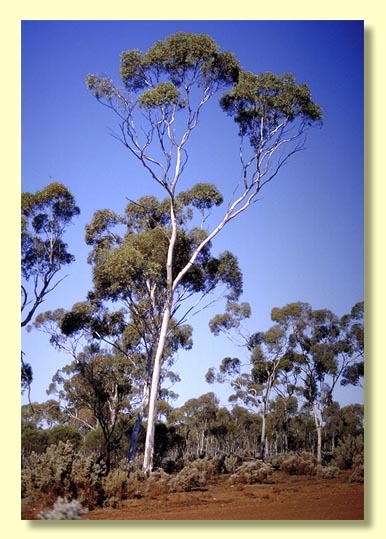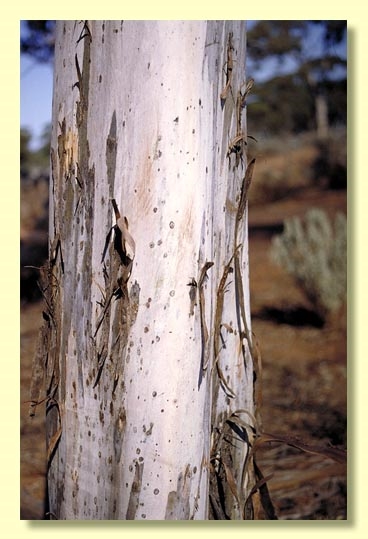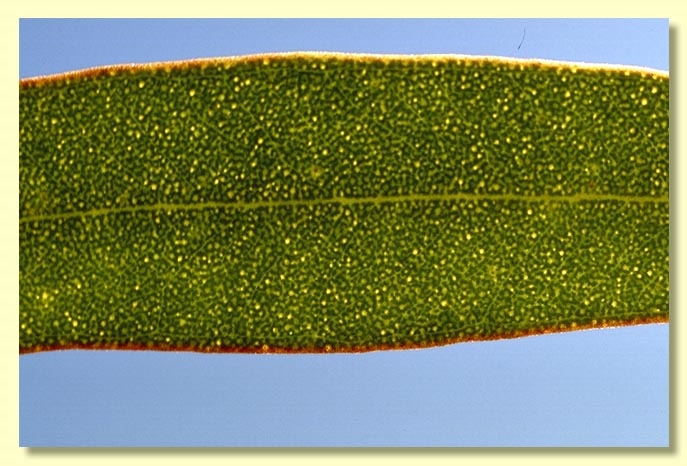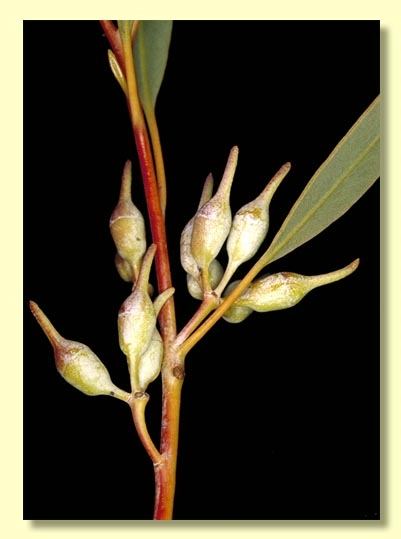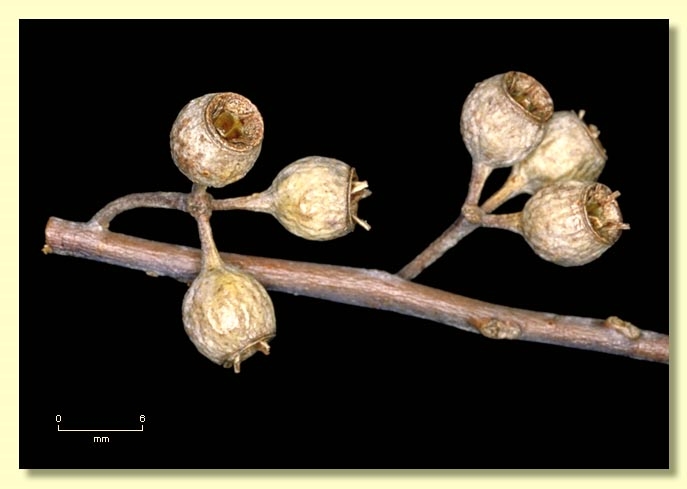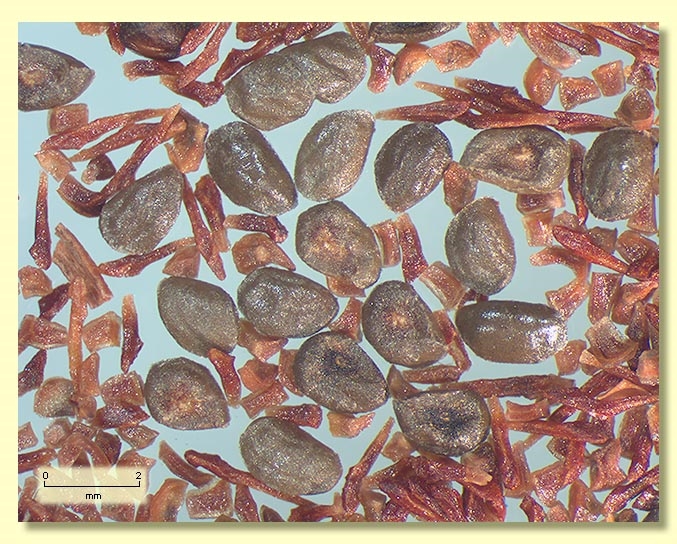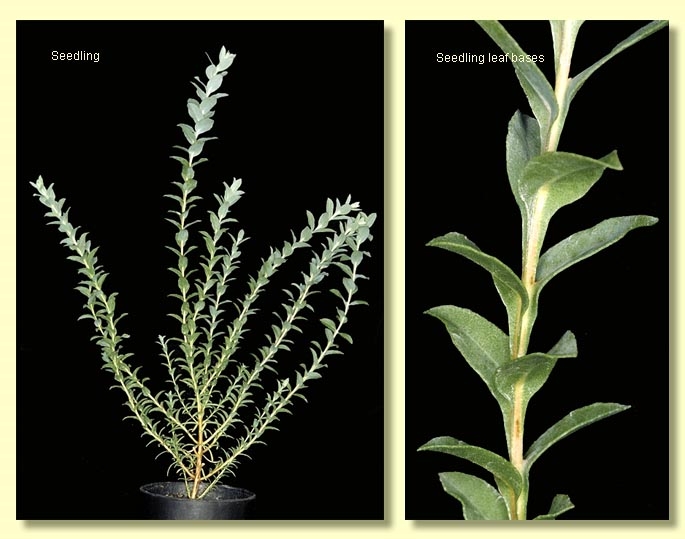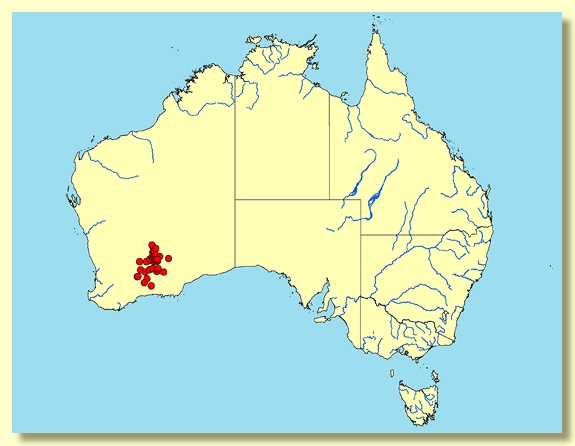Euclid - Online edition
Eucalyptus transcontinentalis
Eucalyptus | Symphyomyrtus | Bisectae | Destitutae | Subulatae | Decurrentes
T: Western Australia: Kalgoorlie, Sep. 1909, J.H.Maiden s.n.; holo: NSW348889.
Eucalyptus uncinata var. rostrata Benth., Fl. Austral. 3: 216 (1867), in part. T: Western Australia: cited as "Phillips Range, Maxwell; Murchison River, Oldfield, also Drummond, 5th collection n. 186" see: L.A.S.Johnson & K.D.Hill, Telopea 8: 199 (1999) for further clarification.
Eucalyptus oleosa var. glauca Maiden, J. Western Australian Nat. Hist. Soc. 3: 171 (1911). T: Western Australia: 70 miles north of Kurrawang, J.H.Maiden, Sep. 1909; lecto: NSW fide L.A.S.Johnson & K.D.Hill, Telopea 8: 199 (1999).
Bark smooth throughout, white to grey with pale pink or pale orange patches.
Branchlets glaucous; lacking oil glands in the pith.
Juvenile growth (coppice or field seedlings to 50 cm): stem square in cross-section, glaucous to non-glaucous; juvenile leaves opposite becoming alternate further up the stem, sessile, ovate to rarely elliptic, base decurrent on stem, margin entire, apex pointed, 3.5–5.5 cm long, 1.3–2.5 cm wide, dull grey-green to glaucous.
Adult leaves alternate, petiole 0.8–2.2(2.5) cm long; blade lanceolate, sometimes falcate, 5–15 cm long, 0.8–2 cm wide, base tapering to petiole, concolorous, dull, blue-green to green, side-veins at an acute or wider angle to midrib, moderately to densely reticulate, intramarginal vein parallel to and just within margin, oil glands mostly intersectional.
Inflorescence axillary unbranched, peduncles 0.5–1.6 cm long, erect to pendulous; buds usually 7, rarely more than 7, pedicellate, pedicels 0.4–0.7 cm long. Mature buds ± ovoid to oblong (1.3–2.2 cm long, 0.4–0.6 cm wide), glaucous, scar present, operculum beaked to horn-shaped (0.8–1.5 cm long), stamens irregularly flexed, anthers versatile, basifixed, globoid, dehiscing by slits, style long, stigma tapered, locules 3 or 4, the placentae each with 4 vertical ovule rows. Flowers pale yellow.
Fruit erect to pendulous, pedicellate, pedicels 0.3–0.6 cm long, urn-shaped to barrel-shaped, rarely truncate-globose, usually glaucous but glaucescence weathering with age, 0.6–1 cm long, 0.5–0.9 cm wide, disc descending, valves 3 or 4, valve tips strongly exserted due to fragile style remnants.
Seeds brown to grey, 1.5–2 mm long, ovoid or flattened-ovoid, rarely pointed at one end, occasionally with shallow longitudinal furrows on otherwise smooth dorsal surface, hilum ventral.
Cultivated seedlings (measured at node 10): cotyledons Y-shaped (bisected); stems square in cross-section and prominently winged due to decurrent leaf bases; leaves opposite, sessile, linear for the first few nodes then linear to ovate to elliptical, dull grey-green to glaucous, 1.2–3 cm long, 0.3–1.7 cm wide, leaf base decurrent on stem.
Flowering has been recorded in August, September, October and December.
A small to medium-sized smooth-barked tree endemic to southern and central goldfields of Western Australia, widespread from the Frank Hann National Park area (just west of Salmon Gums), east to the Fraser Range area, then north through the Kalgoorlie–Coolgardie–Southern Cross region to just south of Menzies. It has a dull bluish green crown, glaucous branchlets, strongly beaked buds in clusters of 7 and yellowish flowers. The margins of the seedling and juvenile leaves are continuous with the stem (decurrent).
Eucalyptus transcontinentalis belongs in Eucalyptus subgenus Symphyomyrtus section Bisectae subsection Destitutae because buds have two opercula initially, cotyledons are Y-shaped and branchlets lack oil glands in the pith. Within this subsection E. transcontinentalis is part of the large taxonomic series Subulatae further characterised by globoid basifixed anthers, grey smooth seeds with shallow longitudinal furrows, and fruit with persistent exserted style remnants. Series Subulatae is divided principally into four subseries based on the juvenile leaves, one with spiral, crowded seedling phyllotaxis (subseries Spirales), another with decussate and strongly decurrent seedling leaves (subseries Decurrentes), another with decussate non-decurrent seedling leaves (subseries Decussatae), and a fourth with disjunct, petiolate seedling leaves (subseries Oleaginae).
Eucalyptus transcontinentalis is part of subseries Decurrentes. It is most closely related to E. moderata (from the northern wheatbelt extending eastwards to north of Kalgoorlie) and E. hypolaena (from east of Kalgoorlie). Both these are easily distinguished from E. transcontinentalis by the black butt of rough bark. E. transcontinentalis is also closely related tothe smooth-barked mallet, E. optima, which occurs east of Norseman towards Balladonia. This species has larger buds and fruit, the fruit being truncate-globose rather than urn-shaped, as they commonly are in E. trancontinentalis. All four taxa have lemon-yellow flowers.
Another smooth-barked tree species very closely related to E. transcontinentalis is the recently described E. rhomboidea which has a restricted distribution west of Salmon Gums. It is similar in most respects except the shape of the buds, which are not beaked and vaguely disamond-shaped in outline, and the fruit which are cup-shaped rather than urn-shaped. The juvenile growth of the two species in indistinguishable. The distribution of E. rhomboidea is an isolated area within the distribution of E. transcontinentalis but the two don't grow together.
The subspecies E. transcontinentalis subsp. semivestita included an earlier edition of EUCLID is now regarded as being synonymous with E. moderata.
Eucalyptus transcontinentalis: referring to the Transcontinental Railway Line which passes through the area of its distribution, Western Australia.

